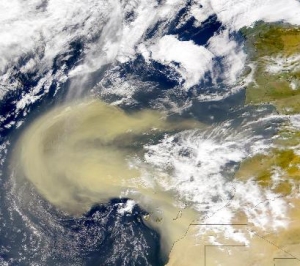Atmospheric Problems

Credit: SeaWiFS Project, NASA/Goddard Space Flight Center,
ORBIMAGE
The Earth's atmosphere is vital for life. But did you know it can cause problems for astronomers. Some kinds of light can not get through the atmosphere at all! So when astronomers build a new professional telescope, they choose a place which minimises the problems caused by the air.
Some problems include:
- Weather - It is almost impossible to see the night sky through thick cloud! That is, unless you are doing radio astronomy. Radio telescopes can 'see' through cloud because radio waves can travel through it.
- Light Pollution - Modern towns and cities have lots of lights on at night. These lights fill the sky with a white or orange glow which makes it much more difficult to see the stars.
- Blurring - The atmosphere acts a bit like a "frosted" glass window. Images of stars and galaxies can look blurred and fuzzy. Astronomers call this effect, seeing. The seeing is also why stars look like they "twinkle".
- Transmission - The amount of light that gets through the atmosphere is called the transmission of the atmosphere. The less air we look through the more we can see. So it is better to do astronomy at high altitudes or from space!
Professional astronomers usually put their telescopes on high mountains above most of the clouds. They are also often in remote areas, well away from towns and cities. Often, the best place is on an island. The sea keeps the atmosphere more stable, so there is less blurring. This is why the Liverpool Telescope is on a mountain in the island of La Palma!
Radio telescopes (like the SKA) are usually built away from electrical noise and radio transmissions. These can interfere with the radio light from space. Some telescopes have even been launched into space. This avoids all problems caused by the Earth's atmosphere.

